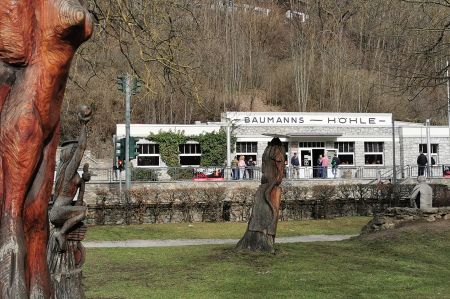Travelling Rübeland to visit Baumann's cave
- Written by Portal Editor
In addition to hiking and cycling trails, the Harz also offers a large number of stalactite caves that are worth visiting when the weather is not exactly inviting for hiking or cycling.
We used such a day to drive to the so-called Baumannshöhle in Rübeland. The Baumannshöhle is the oldest show and visitor cave in Germany, which is also right next to the Hermannshöhle, another stalactite cave.
The legend of the miner Friedrich Baumann
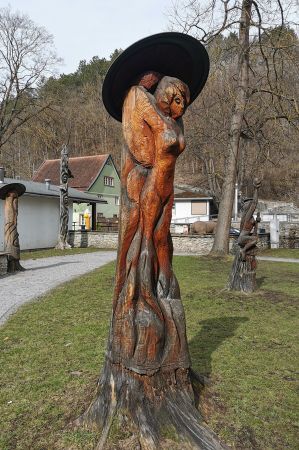 According to an unproven legend, the cave was discovered around 1536 by the miner Friedrich Baumann, who is also said to have given the cave its name.
According to an unproven legend, the cave was discovered around 1536 by the miner Friedrich Baumann, who is also said to have given the cave its name.
Baumann is said to have accidentally entered the cave while looking for an ore deposit and got lost there after his pit light went out.
After three days he managed to find the exit again. Although he was supposedly able to report on the cave, he then died as a result of the deprivation.
The date "1536" associated with the legend was invented during the Nazi era in the 1930s in order to be able to celebrate a 400th anniversary.
Origin and current use of the Baumannshöhle
The cave was formed in the Devonian limestone of the Elbingerode Complex in connection with the formation of the Bode Valley in the area of old faults in the earth strata. The Baumannshöhle consists of several interconnected cavities. One example is the so-called “Lighter Gorge”, which is characterized by many one-meter-high stalagmites. The largest room is the Goethe Hall with a floor area of around 2500 m², where concerts are also held and plays are occasionally performed during the school holidays.
For these purposes, there are two stages and seats for up to 300 spectators in this hall. There is also an artificially created lake that is up to 80 centimetres deep, the so-called Wolfgangsee. The Goethe Hall is also a branch of the local registry office, as bridal couples have been able to get married in the Baumannshöhle since 2000. Until 1928 the hall was called the dance hall.
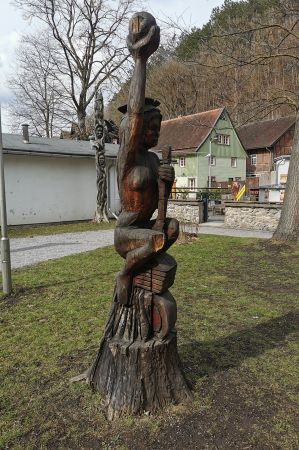 The highest point of the cave, the Kingdom of Heaven, is 440 m above sea level. NN; the deepest point is the waterway 61 meters below. In a cave known as the Hamburg Coat of Arms there is a rock formation that reminded Johann Wolfgang von Goethe of the Hamburg Coat of Arms. Since this smaller cave hall was originally called the Goethe Hall, it had to be given a new name after the dance hall was renamed.
The highest point of the cave, the Kingdom of Heaven, is 440 m above sea level. NN; the deepest point is the waterway 61 meters below. In a cave known as the Hamburg Coat of Arms there is a rock formation that reminded Johann Wolfgang von Goethe of the Hamburg Coat of Arms. Since this smaller cave hall was originally called the Goethe Hall, it had to be given a new name after the dance hall was renamed.
In the Hamburg coat of arms there is also an artificially modified, well-known stalagmite, about one meter high, the so-called "monk". From the Hamburg Coat of Arms you can reach the parts of the new Baumannshöhle discovered in 1888, such as the Turtle Gorge. The name comes from a sinter and fracture formation reminiscent of a turtle.
Other special features are the hanging mountains and the palm grotto, which takes its name from a sinter formation reminiscent of a palm tree. The columned hall, which is characterized by a large number of stalactites, stalagmites, sinter flags and small sinter tubes, so-called macaroni, is considered to be a particularly beautiful room. In this hall there is also a stalagmite called "Tree of Life", which is considered the symbol of the cave.
Cave visitors have been around since the 16th century
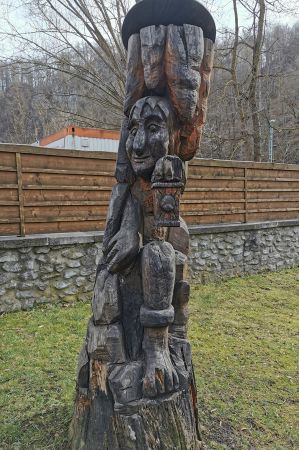 Visits to the cave have been taking place since the 16th century. In 1649, the Dukes of Brunswick granted Valentin Wagner and his family the privilege of guiding visitors through the cave. This time is considered the start of regular tours. Due to the destruction of stalactites, the Duke of Brunswick, Rudolf August, issued an ordinance on April 10, 1668 to protect the Baumannshöhle.
Visits to the cave have been taking place since the 16th century. In 1649, the Dukes of Brunswick granted Valentin Wagner and his family the privilege of guiding visitors through the cave. This time is considered the start of regular tours. Due to the destruction of stalactites, the Duke of Brunswick, Rudolf August, issued an ordinance on April 10, 1668 to protect the Baumannshöhle.
The cave is therefore also the first natural monument to be legally protected in Germany. In order to prevent unauthorized access, access was secured by a door in 1688, so that the stalactite decoration has essentially been preserved to this day. One of the most famous visitors was Johann Wolfgang von Goethe, who visited the cave in 1777, 1783 and 1784. Other well-known visitors were the theologian Gottfried Olearius in 1656 and the philosopher and scientist Gottfried Wilhelm Leibniz in 1690.
The oldest depiction of the inside of the cave is from 1654 by Matthäus Merian. The oldest cave plan dates back to 1665. The Baumannshöhle became, along with the Brocken, one of the most famous sights in the Harz Mountains and thus gained importance as an important economic factor for Rübeland. At that time, the nearby Biels Cave was also open to visitors.
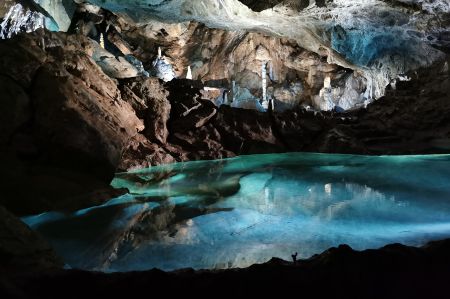 Access to the Baumannshöhle was located high on the western slope of the Bodetal, making it difficult to access the cave. A more thorough exploration of the cave followed from the second half of the 19th century. On July 1, 1888, the cave guide Streitberg found access to a previously unknown part of the cave, which was called the New Baumann Cave. In the same year, Chief Forester Nehring drew up an exact plan of the cave.
Access to the Baumannshöhle was located high on the western slope of the Bodetal, making it difficult to access the cave. A more thorough exploration of the cave followed from the second half of the 19th century. On July 1, 1888, the cave guide Streitberg found access to a previously unknown part of the cave, which was called the New Baumann Cave. In the same year, Chief Forester Nehring drew up an exact plan of the cave.
When regular guided tours began on May 1, 1890 in the neighbouring Hermannshöhle, which was also equipped with electric light, the number of visitors to the Baumannshöhle fell. Her poor condition certainly contributed to this; Sooted cave walls and dull stalactites testified to the use of pitch torches, numerous stalactites had been removed as souvenirs or for sale, and Bengal fires were intended to entertain visitors.
Radioactivity in the Baumann Cave
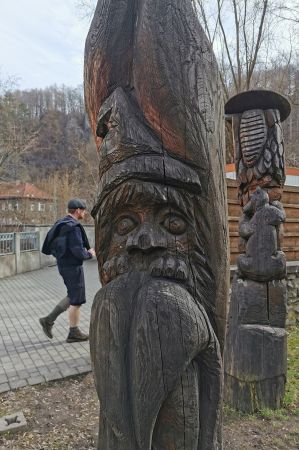 In what is now the Goethe Hall of the cave, investigations into natural radioactivity were carried out in 1901 by the Wolfenbüttel researchers Elster and Geitel.
In what is now the Goethe Hall of the cave, investigations into natural radioactivity were carried out in 1901 by the Wolfenbüttel researchers Elster and Geitel.
In 1928/1929 Stolberg carried out a partial re-measurement of the Baumannshöhle.
A new entrance was built in 1927/28; since then, visitors have entered the cave from the entrance hall in the centre of the village via a 74 meter long, steeply ascending tunnel.
The old entrance was closed to the public and is now only used for operational purposes. New paths have also been laid inside, although not all parts of the cave are still open to the public.
New Stone Age finds came to light during excavations in 1965. In the 1990s, investigations and measurements were carried out by the Arbeitsgemeinschaft für Karstkunde e.V.
Bats use the cave to hibernate
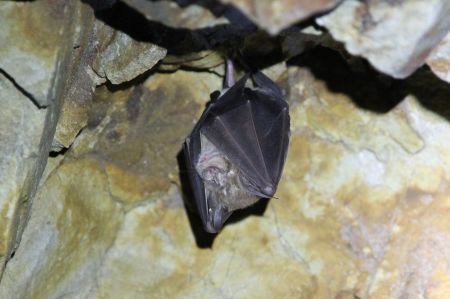 The cave became known, among other things, because of the numerous bones finds of the now extinct cave bear. They were collected in an area known as the Great Bone Field. A reconstructed cave bear skeleton is located here today.
The cave became known, among other things, because of the numerous bones finds of the now extinct cave bear. They were collected in an area known as the Great Bone Field. A reconstructed cave bear skeleton is located here today.
Bats hibernate in the Baumannshöhle. The occurrence of so-called lamp flora is problematic. The growth of mosses and other plants occurs in the vicinity of artificial light sources and can change the appearance of the cave or damage the stones. The phenomenon is counteracted with lighting concepts and cleaning work in winter.
A visitor magnet that is also interesting for children, which gives many details about the cave and its history in almost hourly tours. Understandably, photography is not permitted in the cave, so there are mostly only photos of the park-like area in front of the entrance area, which, however, with its carved wooden figures is also suitable for shortening the waiting time until the next guided tour.
Please read as well:
